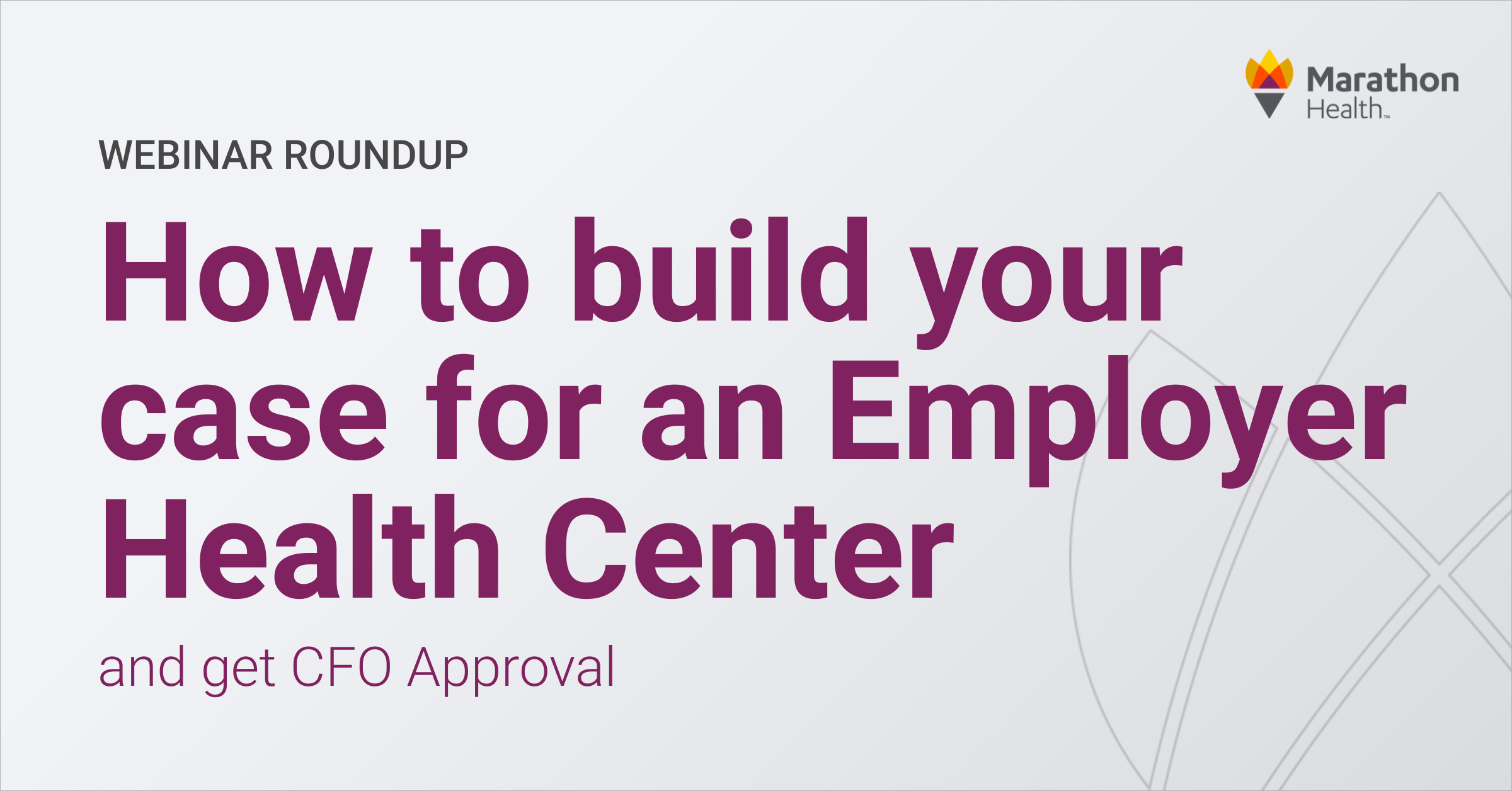Employer health centers move the needle on health outcomes and financial savings. Still, our recent webinar poll says 38% of attendees need help convincing stakeholders it is worth the investment. Conflicting priorities and budget concerns also often play into whether HR leaders should spend the time to build a case for an employer healthcare model.
During our webinar, How to Build Your Case for an Employer Health Center and Get CFO Approval, host Shelly Towns, Chief Marketing Officer for Marathon Health, spoke to our panel about key factors to consider if you want to move forward. The roundtable discussion offered tips for getting buy-in from stakeholders (and employees), advice to look for in a vendor partner, and strategies for measuring the ROI of your employee healthcare program.
The roundtable discussion includes great insights from:
Tracie Lopez, HR Manager, Urschel Laboratories Inc.
Dan Marchetti, Chief Financial Officer, Urschel Laboratories Inc.
Pat Murphy, Chief Financial Officer, Marathon Health
Watch the Full Webinar — How to Build Your Case for an Employer Health Center and Get CFO Approval
How an Employer Health Center Makes an Impact on Lives and Heathcare Costs
Dan recalls that implementing a health center for employees at Urschel Laboratories all came down to crunching numbers 11 years ago. “We knew what it was going to cost us and what the potential savings might be, and we moved forward from there,” he says. But Dan admits that some numbers were difficult to quantify upfront like the time savings realized thanks to providing employees convenient access to healthcare and understanding that employees who are healthier are also more productive and likely to stay with the company.
“We never could really quantify the savings on wellness,” Dan says. “We knew we could save money if we could get our employees dedicated to taking care of their wellness though. We threw estimates on a spreadsheet and when we came back with a number, it made complete financial sense.”
Pat says the cost of a health center and potential claims savings must be reviewed together, not separately, when deciding to launch an employee health center. And he also noted that more progressive CFOs would see the value in soft savings (like access and productivity).
Once you implement a health center, you ultimately want ongoing proof for your CFO that a health center is moving the needle. Pat recommends finding a vendor that not only provides data on outcomes but also makes recommendations to continue improving the overall population health of your employees. “Make sure your vendor can provide actionable data upfront,” he says.
Dan says providing employees access to prescriptions through Marathon Health, along with labs, was another area of cost savings that should be considered when implementing a health center.
Dan and Tracie knew preventive care through the health center would be crucial to contain the company’s healthcare costs. “Acute care, of course, when you have the cold or the flu is important, but those preventive measures are where we’ve seen our numbers improve. It used to be 40% preventive and 60% acute care visits at our health center, and now we’re seeing the opposite which is exactly what we wanted.”
Urschel Laboratories also sees an 82% employee engagement rate with the health center. Finding a vendor who works with you to develop a marketing engagement strategy will increase utilization. Tracie says they give employees a free day off if they reach 100 points for healthcare visits, preventive care and participating in wellness programs. “We’re in our second year of offering this. So, if they go for their biometric screening, they get 20 points, or they go see their dentist or get a vision exam… they get another 20 points. Right now, we have a step challenge to earn points. An annual exam at the clinic earns points, too. We had around 175 employees out of 500 participated last year, which is a great number for us.”
In our second webinar poll, 40% of attendees said the no. 1 goal they’d like to achieve by implementing a health center would be to improve employee health and wellness, followed by lowering healthcare costs at 32%, and seeing a return on investment (ROI) at 20%.
Employers should see a 2:1 ROI by year two with a health center vendor partner. Dan says they aim for a 21% ROI for their health center, but ultimately, improving employees’ lives and their health is the ultimate goal. “Even if we fall short, we’re still comfortable that we’ve made the right decision.”
Watch the full video to learn tips and tricks to build your case for an employer health center! (And share it with your CFO)
Additional Content You Might Like
How Can Employers Influence Healthcare Policy to Improve Benefits and Health Services?
You might also like
Subscribe to our newsletter and stay on the cutting edge of worksite healthcare.






